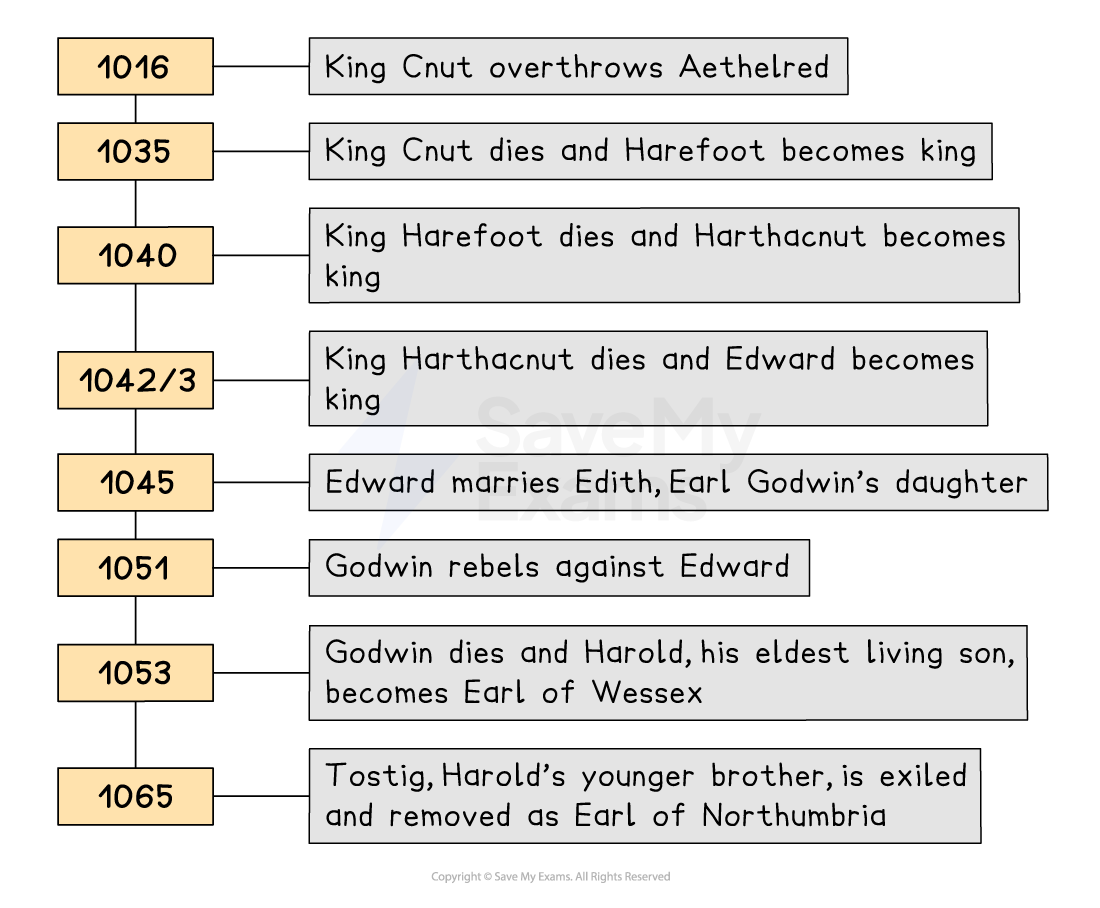The Rise of the Godwins (AQA GCSE History): Revision Note
Exam code: 8145

Summary
The Godwins first rose to power under the reign of King Cnut. By the time Edward the Confessor came to the throne in 1043, they were the most powerful family in England. The power and influence led to tensions with the King and caused the Godwins to be exiled from England after a rebellion in 1051. They soon returned and by the time of Edward the Confessor’s death in 1066, Godwin’s sons held several key roles in England.
Who were the Godwins?
After the King, the Godwins were the most powerful family in Anglo-Saxon England
The family grew in importance when the Viking King Cnut overthrew King Aethelred and ruled in England between 1016 and 1035
Cnut divided the part of England he ruled into four earldoms: Mercia, Northumbria, East Anglia and Wessex
Godwin was not a Viking but Cnut trusted him and appointed him Earl of Wessex
When Cnut died in 1035, his son Harefoot and then Harthacnut had brief reigns
When Harthacnut died in 1042, he was succeeded by Edward - the son of Aethelred
Edward the Confessor was crowned King in 1043
During the many changes in the kings of England, the Godwins maintained their importance and power
To secure the support and loyalty of this powerful family, King Edward married Earl Godwin’s daughter Edith in 1045

The Godwin’s control of England
Wessex was the largest and most important earldom in England
The Godwins controlled land in the south of England that stretched from Norfolk to Cornwall
The land brought them enormous wealth but they were also strategically important areas to control
The lands in the south were key in the defence against invasions from France
The lands in the west were important for launching attacks against Wales
Godwin’s exile & death
The power and wealth of the Godwins rivalled that of the King
Edward hoped marriage to Godwin’s daughter would guarantee his loyalty and support but in 1051 the Godwins rebelled against him
The rebellion was defeated with the aid of the Duke of Normandy and the earls of Northumbria and Mercia
Edward exiled the Godwins from England
Alarmed by the growing influence of the Normans in Edward’s court, the Witan asked the Godwins to come back
Less than a year after their departure, they arrived back in England with an army so large that Edward was unable to prevent their return
By the time Godwin died in 1053, his family had restored its power and influence
His sons all became important figures in their own right and, as they were Godwin’s children, had the surname Godwinson

Harold Godwinson
At the time of Godwin’s death in 1053, Harold was Godwin’s oldest surviving son
He became the Earl of Wessex and therefore controlled England’s richest earldom
He also held a powerful position in the Witan as Edward’s advisor
Tostig Godwinson
The Godwin’s control of England spread to the north and Tostig became Earl of Northumbria
He was a harsh and unpopular leader and the nobles of Northumbria launched a rebellion against Tostig in 1065
Harold persuaded King Edward to agree to the Northumbrian demands and remove Tostig as Earl
Tostig was exiled and felt his brother had betrayed him
Other Godwins
Gyrth Godwinson
Gyrth became the Earl of East Anglia in around 1057
He worked closely with his brother Leofwine to defend and control the areas of England most at threat of invasion from France
Leofwine Godwinson
Leofwine became the Earl of Kent in around 1057
He worked closely with his brother Gyrth to defend and control the areas of England most at threat of invasion from France
Sweyn Godwinson
Sweyn was Godwin’s eldest son and held power and influence as a young man
Controversy, scandal and accusations of abducting an abbess in 1046 led to him being exiled from England
He is believed to have died whilst returning from a pilgrimage to Jerusalem
Examiner Tips and Tricks
You could get a question about claimants to the throne in 1066. Understanding Harold Godwinson’s origins and his relationship with Edward the Confessor is essential to be able to explain the wider context of the strength of the various claims. You can find information in our exam skills pages to help you answer these questions.

Unlock more, it's free!
Did this page help you?